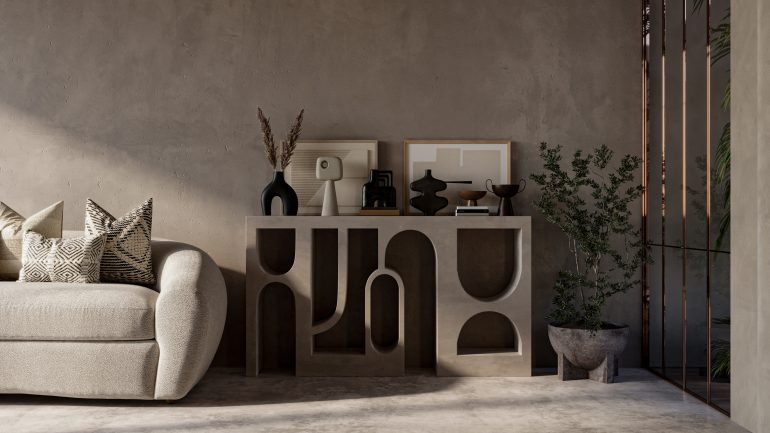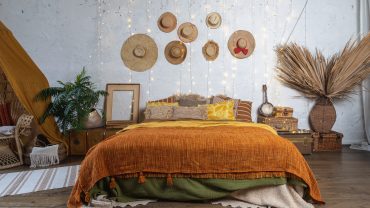What is contemporary style? Unlike fixed styles that are tied to a particular era or element of design – French country design or Japandi design for example – contemporary decor fluidly reflects the tastes, trends, and technologies of the here and now. Therefore, what is considered contemporary today might be viewed as dated in as little as five years, only to be replaced by a new definition of the meaning of contemporary interior design.
Where interior inspiration is concerned, very few questions have a simple – or single – answer and ‘what is contemporary design’ is one of them. It’s a style that adapts to current and emerging trends and it borrows characteristics from other design styles such as Art Deco, futurism, modernism, (we’ll get to the difference between contemporary design and modern design in a second), and others.
To understand the answer to the question ‘what is contemporary style’ is to recognise the beauty of the ever-evolving nature of style and the freedom of versatility, spontaneity and experimentation.
So, whether you’re kitting out a new-build or just looking to bring a touch of now to an urban apartment, understanding the essence of contemporary interior design is the key to creating an inviting, warm, and timeless space.
Contemporary Design & Modern Design: What’s the Difference?

Modern living space (Credit: Michael Robinson via Getty Images)
In modern parlance, the words themselves are used interchangeably, but when it comes to interior design styles, contemporary and modern are markedly different.
Modern design can be dated to the early part of the twentieth century – some say between the dawn of the century and the fifties – and is associated with the modernist movement. Modern design was influenced by German Bauhaus and Scandinavian designs, and to a lesser extent, the International Style and even certain principles of Japanese design. It focuses on form and function, straight lines, a neutral colour palette, uncluttered space and elements of chrome and glass.
In contrast, contemporary design borrows elements from various eras and styles, making it more eclectic and adaptive, yet always capturing the zeitgeist of the current moment.
By definition, it’s hard to pin down a specific starting point for contemporary interior design, but after World War II, as the modernism movement was becoming well-established, design elements started to shift in response to changes in technology, culture, and society. The 1970s and 1980s are particularly notable for the rise of postmodernism, which challenged the strict rigidity and functionality of modernism with more playful, eclectic, and ornate designs.
It’s during these decades that we could begin to answer the question ‘what is contemporary style.’ It started to emerge more prominently as a stand-alone movement, incorporating elements from both modern and postmodern design, yet always adapting and updating to reflect current trends and technologies. This adaptability is what makes contemporary decor unique. It’s not defined by one era or a rigid set of guidelines, it continually evolves to incorporate the best of all design movements while staying rooted in the present.
Contemporary Furniture

Interior of a contemporary living room with contemporary furniture. (Credit: alvarez via Getty Images)
When considering the furniture that epitomises contemporary interior design, think sleek, functional, and, on occasion, unexpected. Contemporary furnishings can have asymmetrical shapes, bold geometric forms, or incorporate innovative materials. It’s not unusual to find a juxtaposition of textures or materials in a single piece, like a glass tabletop supported by a sculpted wooden base. It also incorporates a dramatic blend of natural and industrial, such as nickel, polished steel or brass paired with leather, linen or jute.
One of the key elements of contemporary design is the use of space and the seamless flow it can create. Bordering on minimalism, luxurious simplicity is one way to think about setting up your living areas. Uncluttered and sophisticated is another. Some designers prefer stark minimalism but a balance of warm and welcoming without feeling overcrowded is a good starting point.
Creative Colours

Living room utilising contemporary interior design colours. (Credit: CreativaStudio via Getty Images)
Colour palettes in contemporary design lean towards neutrality, but with an edge. Shades of grey, taupe, and cream, often punctuated by bold and vibrant accents, such as a striking azure blue couch or a bright yellow accent wall, can create a dynamic atmosphere.
However, the use of colour in contemporary design is not just about boldness; it’s also about balance. Harmonious and thoughtfully curated colour combinations are central to this style, ensuring spaces feel both inviting and innovative.
Flooring & Lighting

Modern and contemporary luxury living room interior (Credit: ExperienceInteriors via Getty Images)
The approach to flooring in contemporary interior design leans towards the use of materials like hardwood, polished concrete, and large-format tiles. The key, like much of contemporary design, lies in its simplicity, with preferences veering towards wide plank floors with minimal graining or subtly patterned tiles. Yet, warmth isn’t sacrificed. Area rugs, often with geometric or organic-inspired designs, add texture and vibrancy.
Contemporary design frequently treats light fixtures as sculptural artworks. LEDs currently dominate for their efficiency and adaptability, making way for features like under-cabinet lighting or recessed ceiling lights. These fixtures, defined by clean lines and minimalist profiles, include everything from statement pendant lights to floor and table lamps. Yet, above all, contemporary spaces place a premium on natural light, often boasting large, simply-treated windows, skylights, and open floor plans, ensuring an abundant flow of sunlight and forging a harmonious connection between outside and in.
Live for Today

Contemporary and cozy living room. (Credit: Gokcemim via Getty Images)
In the ever-evolving landscape of interior design, contemporary decor stands out as a testament to the present, capturing the essence of current trends, technologies, and tastes. It marries functionality with aesthetics, creating spaces that are not only reflective of the times but also warm, inviting, and versatile.












